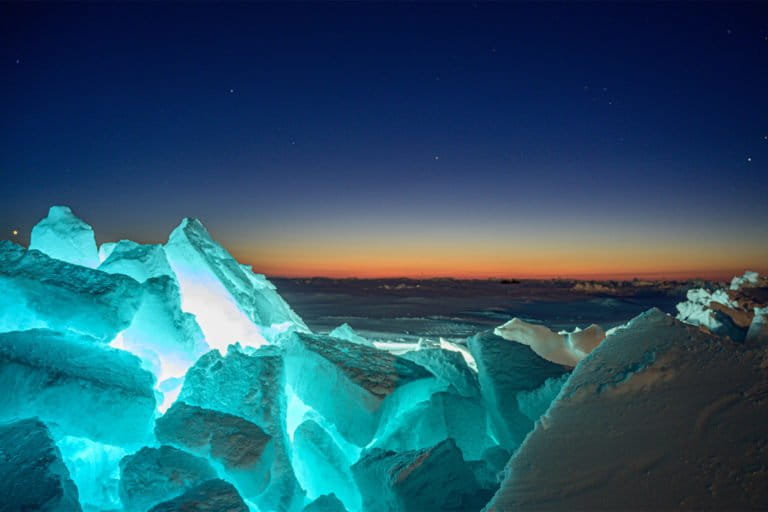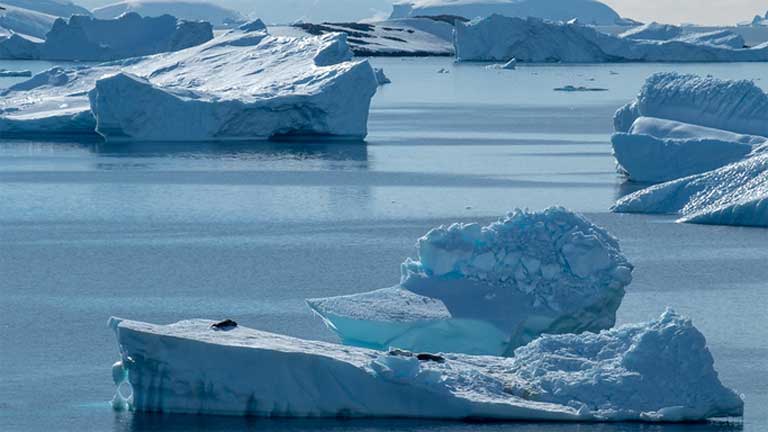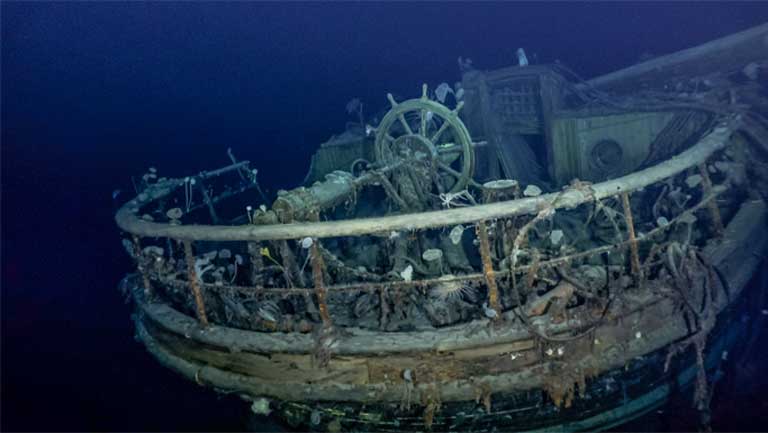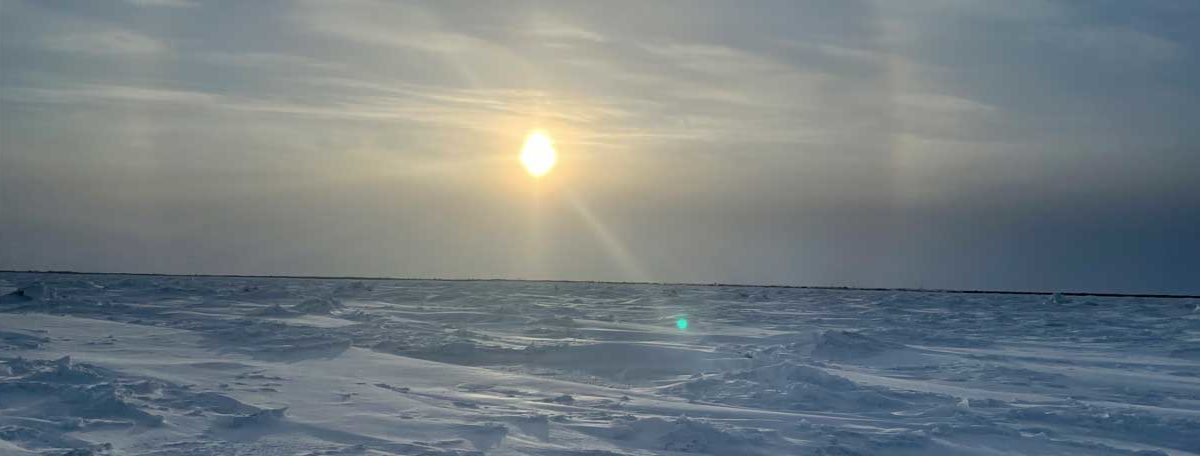- Arctic sea ice has reached its yearly maximum extent at 14.88 million sq. km., the 10th lowest on record. The up-and-down story of sea ice extent in the past year highlights how unpredictable it can be from season to season, even as the overall decline continues.
- A study employing new satellite data found that Arctic multiyear sea ice — ice that survives the summer melt — is thinning even faster than previously thought and has lost a third of its volume in just two decades.
- This comes as Antarctic sea ice extent hit a record summer low, raising questions whether it is beginning a long-term decline, although experts are wary of drawing conclusions yet.
- While summer Arctic sea ice is predicted to mostly disappear by 2050, a new study suggests we could likely preserve it through 2100 by aggressively cutting methane emissions by 2030, along with reaching net-zero CO2 emissions by 2050.
Arctic sea ice has reached its annual maximum at 14.88 million sq. km. (5.75 million sq. mi.), the 10th lowest winter extent since satellite monitoring began in 1979.
The annual maximum was announced after temperatures at the North Pole shot up higher than normal by 28° Celsius (50° Fahrenheit) last week, close to the melting point, because of warm air delivered by a fast-developing “bomb cyclone” originating on the U.S. East Coast.
Although ice extent is far from the worst scientists have seen, it is still 770,000 sq. km. smaller than the 1981-2010 average winter maximum and came on February 25, the second earliest date on record. Not only the quantity but also the quality of the ice is deteriorating remarkably fast, new research suggests.
“We’re losing the older ice, the multiyear ice,” said Mark Serreze, director of the National Snow and Ice Data Center. “There used to be stuff out there that was 10 to 12 years old. That’s gone. So there’s no secret here, you’re losing multiyear ice, you’re transitioning to a first-year ice kind of regime.”
With less sea ice to reflect sunlight in the summer, the Arctic Ocean is absorbing more sunlight, a feedback that is speeding up global warming.
But as in the past, sea ice conditions have varied greatly in the last year. In July, Arctic sea ice was on course to set a record summer minimum extent, but ended up only the 10th lowest on record following a spell of cool, cloudy weather in August.
This winter, much of the Gulf of St Lawrence in Canada and the Sea of Okhotsk off Russia’s eastern coast remained ice-free, as did a tongue of open water north of Novaya Zemlya in the Barents Sea. Otherwise, the ice edge was relatively near its 1981-2010 median and actually exceeded it in Baffin Bay and off the coast of southeastern Greenland. Even though more and more warm water from the Pacific Ocean has been flowing into the Bering Sea in recent years, ice extent was near average there after low atmospheric pressure south of Alaska’s Aleutian Islands brought cold winds down from the Arctic in January, which helped form ice and push it south.
The variability of Arctic sea ice is part of the reason why the National Snow and Ice Data Center waited almost a month to call the annual maximum. Nonetheless, the overall tendency is toward less ice in every season, Serreze noted.
“We’ve been having a discussion on the problem of sea ice predictability,” he said. “You don’t know what weather patterns are going to be more than a week or two out. That can change everything. We’re still working on it, but we know the trend, we know it’s going to be a low sea ice extent.”

Multiyear ice may be thinner than we thought
Previous research has warned that the Arctic could be nearly ice-free in summer as soon as 2035, as the “reservoir” of thick multiyear ice that has survived at least one summer melt cycle gradually vanishes. But there may be even less multiyear ice left than previously thought, a study published this month suggests.
Key for calculating ice thickness from space is estimating the amount of snow that is weighing down sea ice, causing it to ride lower in the water. Traditionally, that’s been calculated using snow depth records from the mid-20th century. The new study instead estimated snow depth using NASA’s ICESat-2 satellite, which measures height of snow and ice above the water, and the European Space Agency’s CryoSat-2, which measures only the height of the ice.
The researchers calculated that Arctic sea ice volume has decreased by 12.5% in just the three years since ICESat-2 was launched, mostly due to the thinning of multiyear ice. That’s a greater loss than what was calculated in the past using only snow depth records. In less than two decades, Arctic sea ice has lost 6,000 cubic kilometers (1,400 cubic miles), or a third of its winter volume, the researchers found.
“New observations of snow depth show that previous estimates of ice thickness might have been overestimated,” said lead author Sahra Kacimi, a polar scientist at the NASA Jet Propulsion Laboratory.

Despite some uncertainty around how well the CryoSat-2 radar penetrates snow and meltwater pooled on top of ice, this new monitoring approach provides the first pan-Arctic snow depth estimates and will help researchers better understand the impact of snow on ice growth and decay, she added.
Despite the dramatic decline in multiyear sea ice, it may not be too late to save it, another study this month reported. Taking all feasible steps to reduce methane emissions by 2030, in combination with reaching net-zero CO2 emissions by 2050, could diminish the likelihood of losing summer Arctic sea ice this century to one-in-five, scientists found.
“Even if we achieve net-zero CO2, that doesn’t guarantee avoiding ice-free summers, but if we cut methane with the technology we have today we improve our chances to 80 percent,” said lead author Tianyi Sun, a climate scientist at the Environmental Defense Fund, an NGO.
The non-profit environmental group plans to launch a satellite to better track methane emissions from oil and gas operations on a SpaceX rocket this fall.

Antarctic sea ice reaches record low
Sea ice in the Arctic can only expand so far before it is constrained by landforms. Antarctica, on the other hand, is surrounded by the open waters of the Southern Ocean, as the National Geographic Society officially dubbed it last year. That means Antarctic sea ice extent can grow further before the melt season and can vary even more widely from year to year.
After expanding in 2014-16, the Antarctic sea ice minimum extent fell to a record low in 2017, then grew again before dropping to a new record low of 1.92 million sq. km. (740,000 sq. mi.) on the same day as the Arctic maximum, February 25. Scarcer ice made it easier for an expedition to find explorer Ernest Shackleton’s ship the Endurance with underwater drones, 10,000 feet deep off the west coast of Antarctica on March 9. The Endurance was crushed by the Antarctic ice and sank in 1915.

Last week, parts of eastern Antarctica saw temperatures 40° C (70° F) above normal, shattering records. But winds and ocean currents still seem to be impacting Antarctica’s sea ice more than global warming, scientists say, along with a seasonal ozone hole that cools the atmosphere there by removing UV-light-absorbing ozone particles. This year’s record low in summer sea ice extent may be the beginning of the end of that situation — or not.
“We expect Antarctic sea ice to be lost as the world warms. We expect climate change to overcome the effect of the ozone hole and the ocean currents,” said Zeke Hausfather, a research scientist at Berkeley Earth. “The question now is, are we seeing that [in this year’s record minimum] or just more natural variability in the region? It’s hard to tell the long-term trajectory, we’ll be watching in the next few years.”
Citations:
Sahra Kacimi, Ron Kwok. Arctic Snow Depth, Ice Thickness, and Volume from ICESat-2 and CryoSat-2: 2018–2021. Geophysical Research Letters.
Tianyi Sun, Ilissa B Ocko, Steven P Hamburg. The value of early methane mitigation in preserving Arctic summer sea ice. Environmental Research Letters.
Banner image: Sea ice this year in Canada’s Hudson Bay. Image courtesy of Julienne Stroeve of the National Snow and Ice Data Center.
FEEDBACK: Use this form to send a message to the author of this post. If you want to post a public comment, you can do that at the bottom of the page.
